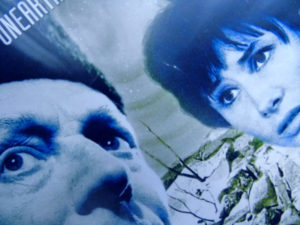An Unearthly Child
“I feel frightened. As if we’re about to interfere in something that is best left alone.” – Barbara
 Though now considered one story, the first episode of An Unearthly Child obviously stands out as the introduction to the series while the latter three are a template for the adventures that would be seen thereafter. We see personalities from the start; the difference between heart-led Barbara and action Ian (“Well, don’t you feel it?” “I take things as they come.”) and the very arch Doctor—both bemused and irritated at these mere humans insisting on telling him what he is going to do (“Oh am I?”). And imagine how odd Susan’s character seemed on first viewing when people would really not have understood why in the world she would both know and not know things. There are also a wealth of great introductory lines upon their discovery of the TARDIS (“I know that free movement in time and space is a scientific dream I don’t expect to find solved in a junkyard!”) or of how alien Susan and the Doctor are (“You’re treating us like children.” “Am I? The children of my civilization would be insulted.”)
Though now considered one story, the first episode of An Unearthly Child obviously stands out as the introduction to the series while the latter three are a template for the adventures that would be seen thereafter. We see personalities from the start; the difference between heart-led Barbara and action Ian (“Well, don’t you feel it?” “I take things as they come.”) and the very arch Doctor—both bemused and irritated at these mere humans insisting on telling him what he is going to do (“Oh am I?”). And imagine how odd Susan’s character seemed on first viewing when people would really not have understood why in the world she would both know and not know things. There are also a wealth of great introductory lines upon their discovery of the TARDIS (“I know that free movement in time and space is a scientific dream I don’t expect to find solved in a junkyard!”) or of how alien Susan and the Doctor are (“You’re treating us like children.” “Am I? The children of my civilization would be insulted.”)
Once we get to Paleolithic times, much is made of the fact that we don’t see the Doctor act as we would later know him, but I would argue that his intelligence and ability to read people is shown here from the start. Of course, we don’t see much of the Doctor as a hero or action taker until episode three. After Ian spends time trying to break their bonds with crumbling rocks, the Doctor finally speaks up with a sigh and tells what is for him the obvious suggestion of using the sharp shards of strong bone. It comes across as though he’s been holding back until this point and is finally ready to take charge as he normally would (as evidenced by Susan’s clear joy and relief that he is at last starting to speak up and deal with things). We also see that the Doctor needs almost no time to discern that Kal was actually the killer of the old lady and to handily manipulate him into showing it with just words and wits. (I would argue this is the Doctor at his best in this story.)
Some don’t like the simplistic script, but I would argue there is some really interesting characterization of the odd ways that cavemen may have reasoned the world. When confronted with the fact that the knife he says was used to kill the old woman has no blood on it, he states “This is a bad knife. It does not show the things it does”. Also interesting is that the cave people seem to have no context for kindness and can only compare it to a mother taking care of her child. Watching it this time, I appreciated this aspect of the show more than ever before.
Best unsettling moments:
That first odd moment when school girl Susan glances at a French history text book and proclaims in amazement “That’s not right!” is a favorite of mine. Even more so the later flashback when she covers her embarrassment of referring to the English decimal monetary system by noting that she forgot it hasn’t happened—-yet. (I won’t delve too much into my childhood psychology but let’s just say Susan’s bewilderment at being teased and laughed at just for knowing too much resonates!)
Firsts:
- Barbara’s startled reaction at bigger on the inside.
- “Doctor who?”
- The TARDIS is a police box. Period.
Regrets:
I wish that it had been the Doctor who came up with the final trick of using fire that helped their escape. It would better have cemented him as the core hero early on.
